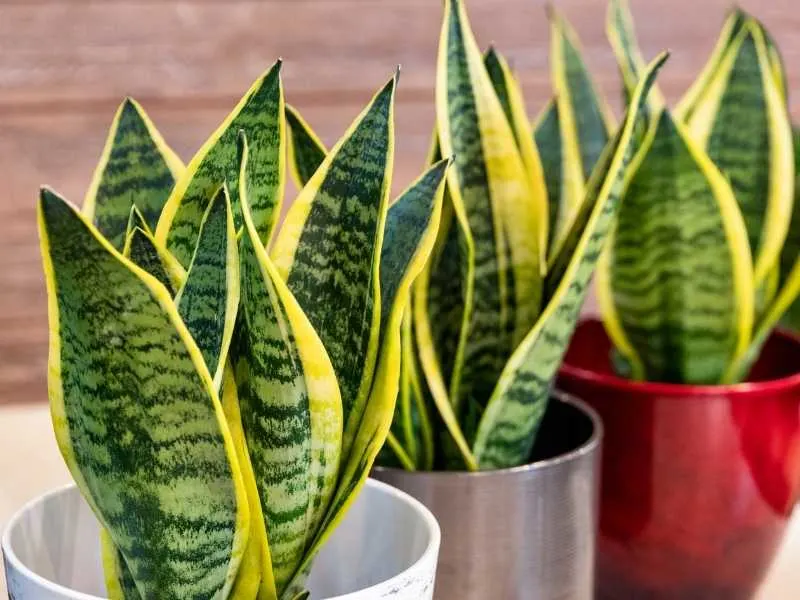Your Snake Plant Dying – Why and Solutions
Snake plant leaves can reach up to ten feet in some varieties. However, if the conditions are unfavorable, the leaves can wither and eventually die.
Sansevieria plants prefer a slightly acidic to slightly alkaline pH level best within 5.5 and 7.5.
These plants aren’t fussy about their soil; however, they like ample light. Snake plants grow well indoors as long as they receive adequate sunlight.
Never place Sansevieria near any heat source, such as heating vents or radiators. Doing so could get the plants burned.
Snake plants require moderate temperatures. In cooler or hotter areas, they may start to wilt. And I have had a few of my readers ask, why is my snake plant dying?
Below is an exhaustive look into why your snake plant is dying and what to do about it.

Related Articles:
- 15 Different Sansevieria Types
- 9 Amazing Spiky Leafed Plants
- How Big Does Mother Inlaw’s Tongue Grow?
Why is My Snake Plant Dying?
The most frequently encountered problem with Sansevieria is root rot, which arises from excessive watering, particularly during winter. (You may want to read this article on how to save an overwatered succulent). In this case, the roots die due to inadequate oxygen or a soil fungus overgrowth.
Cold temperatures damage leaf-cell walls. In effect, this disrupts the flow of water and nutrients while also obstructing water absorption. Ultimately, this causes the plant to die from a lack of moisture.
Still, bugs like spider mites and mealybugs suck sap and kill snake plants in the process. Also, diseases like southern blight and red leaf spots may smother snake plants.
Why Is My Snake Plant Shriveling?
During warm weather, you’ll notice that the leaves are more lush and dark green with more visible stripes. The leaves may begin to wrinkle when the temperature rises. Snake plant leaves split or curl easily in response to high temperatures.
Moreover, when snake plants don’t receive sufficient water, their leaves wrinkle. Brown leaf tips indicate that your plant is drying out. To confirm that underwatering is the cause, feel the soil to determine the dryness level.
Sansevieria leaves curl if planted in non-draining soil due to the likelihood of overwatering. On the other hand, poor water-retaining soil results in excessive water loss, wrinkling the leaves.
Excessive sunlight scorches the leaves and causes them to rapidly lose water, wrinkling them in the process. Snake plant leaves curl and develop brown tips when placed in direct sunlight.
What’s more?
Snake plants may experience shock due to:
- Transportation-related stress
- Environmental change
- Pets nibbling them
When stressed, the leaves gradually begin to wrinkle. Allow the plant to recover naturally; it will progressively adapt to its new environment and thrive again.
How Do I Save My Dying Snake Plant?
Depending on the reason for dying, there are various fixes to save your houseplant.
Dealing Snake Plant Diseases and Bugs
- Red Leaf Spot: Eliminate infected leaves. A sulfur spray or a copper-containing fungicide can treat minor infestations.
- Southern Blight: Remove the infected leaf. Use fungicides like methyl bromide for heavy infestation.
- Spider Mites: Wipe off the bugs with insecticidal soap. Prune in heavy infestation.
- Mealybugs: Remove the pests and eggs by hand or wipe with a swab doused in alcohol.
Other ways to save your dying snake plant include:
Use Substitute Soil
Even if you water your snake plant regularly, it may begin to die if the potting mix has poor drainage. If the snake plant is in regular potting soil, remove it and replace it with specially formulated succulent and cacti soil.
This mix simulates the well-draining soil conditions of the Dracaena plant’s natural habitat. As a result, it significantly reduces the risk of your snake plant dying.
Use Suitable Containers
Snake plants need pots with drainage holes underneath. Excess water must drain freely from the bottom of the pot to avoid the roots remaining in damp soil for an extended period.
Sansevieria plants also need proportionally-sized pots. Larger pots contain more soil, retain more moisture, and dry out much more slowly—thus, increasing the risk of yellowing leaves.
How to Fix Overwatered Snake Plants
Reduce the frequency of watering. If you water your snake plants more than once a week, you are watering them too frequently. Snake plants need replenishing every two to three weeks. Allow the mix to dry out once the leaves turn brown or yellow.
However, watering frequency varies based on the different seasons and circumstances in your home. Hence, it’s best to establish the optimal watering cycle by checking the soil for dryness. The soil should be moist, not overly dry or soaked.
Always check for compacted soil or roots that may obstruct the drainage holes, resulting in slow drainage.
What Do You Do with a Dying Snake Leaf?
Visually check the Sansevieria for indications of overcrowding or inadequate water, which may cause death.
You’ll need to address the underlying cause to prevent more dead leaves, although foliage can die naturally without specific reasons.
Take the dying leaf and grasp it just below the point where the browning ends.
Cut across it as close as possible to the soil.
Still, you can cut the leaf further up, although it’s unlikely to grow taller and may be unappealing.
Cutting at the base can also stop the spread of rot to other leaves and other parts of the plant.
How Do I Fix My Drooping Snake Plant?
- Use well-draining garden soil with organic compost if growing your snake plant outdoors. On the other hand, if you are growing it indoors, use a quick-draining potting mix. Additionally, plant it in a place with dappled sunlight.
- Maintain a warm temperature around your snake plant. The leaves may droop if it becomes too cold.
- Repot or relocate a plant if its leaves begin to droop — this is a common symptom of excessive watering. Remove it from its container. Next, rinse away old soil, and regrow it in a new mix or a better-draining location.
- Snip all drooping foliage. It’s unlikely to revive after repotting, but new leaves will grow out.
Frequently Asked Questions
How Long Does it Take to Revive a Snake Plant?
Sansevieria plants are slow growers. As such, the healing process progresses slowly. Your snake plant should begin to recover within a week with proper revival practices. However, it takes approximately 4-6 weeks to revive a snake plant completely.
Why Is My Snake Plant Turning Yellow and Brown?
Your snake plant is turning yellow and brown due to your watering schedule and bugs. Nonetheless, overwatering is the most common cause of Sansevieria plant yellowing. Snake plants thrive primarily on neglect–they require little water.
Also, switching between complete dryness and wet soil due to erratic watering can cause stress and yellow leaves on your Sansevieria.
Sap-sucking insects such as spider mites can dehydrate your plant. Yellowing foliage is the first sign of this problem.
Why Is My Snake Plant Drying Out?
Your snake plant is drying out due to a lack of water. Sansevierias that don’t receive enough water lose their standard shape and color. Underwatering also disrupts nutrient supply to the entire plant, as water helps snake plants maintain their upright position.
Snake Plants Dying – Conclusion
You can see that your snake plant dying could be a result of various possible reasons. These plants are drought tolerant and require minimal maintenance. However, they do require adequate sunlight and good air circulation.
The ideal environment for your snake plant includes ample light, moderate humidity, and ideal temperatures with an appropriate, well-draining potting mix.

